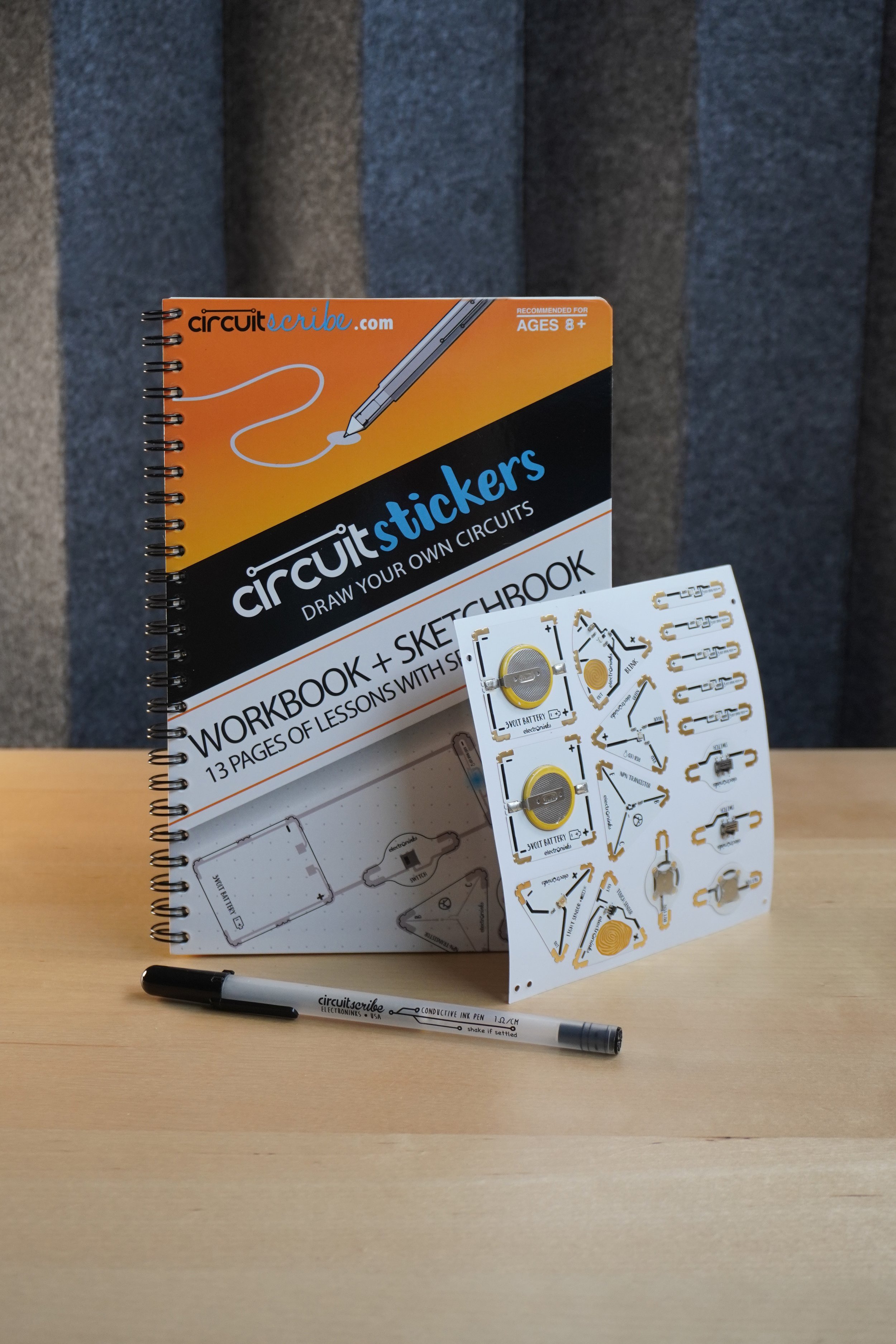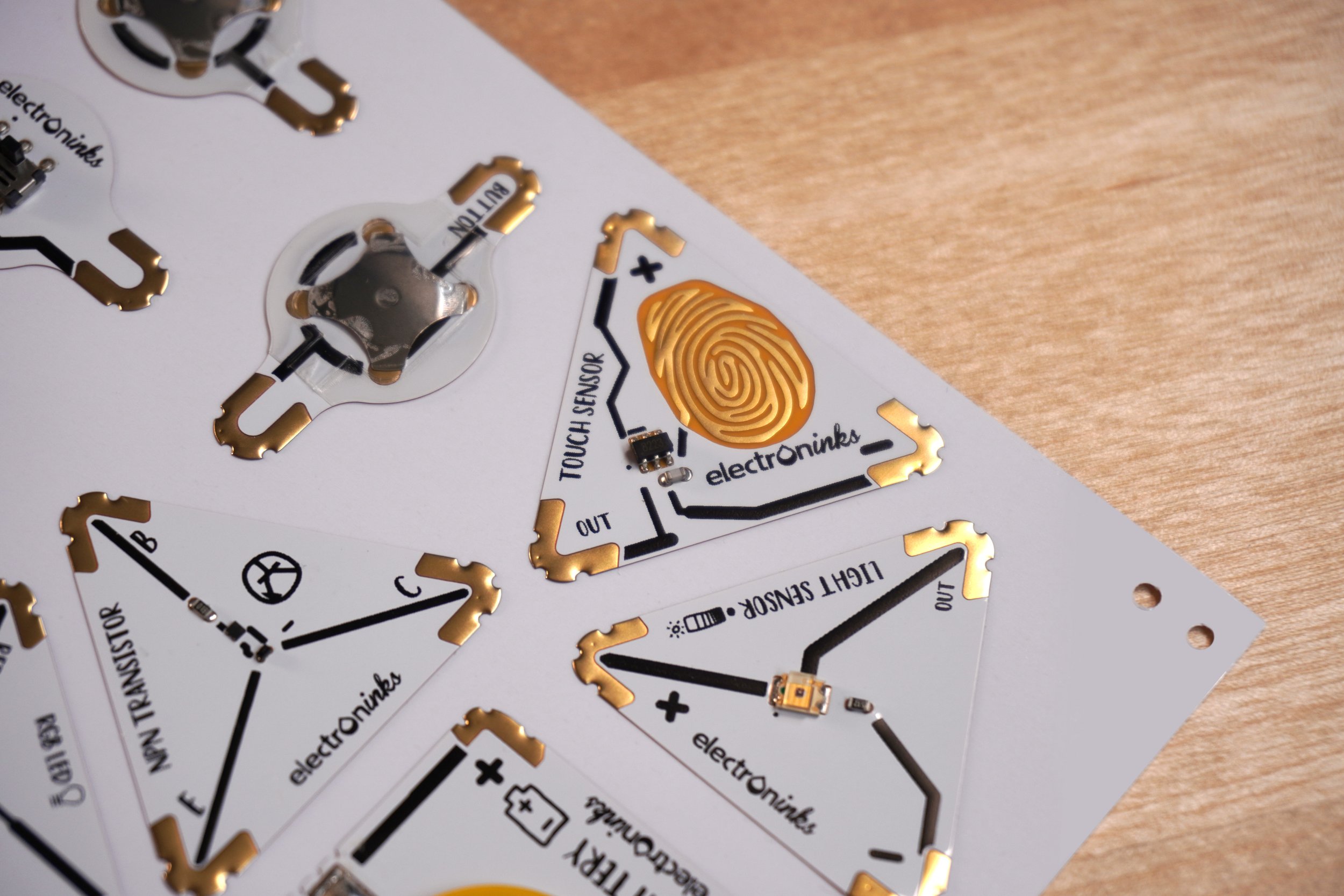Circuit Scribe
Over several years working with Electroninks, I contributed to a suite of open-ended, educational electronics products built around the Circuit Scribe platform, tools designed not just for kids, but for anyone curious about how electronics work. These kits use conductive silver ink to turn drawn lines into functioning circuits, combining modular magnetic components, engaging packaging, and visual clarity to demystify circuitry through hands-on experimentation.
I supported this work across multiple fronts: I illustrated the system’s core modules in a clean, isometric style that became central to its brand identity and to a successful kickstarter campaign; co-developed physical form factors and packaging; and helped shape the user experience across kits designed for very different goals, from learning logic and conductivity to building a working drone.
From the flagship Circuit Scribe kit to its more accessible evolution in Circuit Stickers, to purpose-built learning tools like the Drone Builder Kit and a modular Calculator Kit, this body of work represents a sustained effort to lower the barrier to entry for electronics education through clear, inviting, and thoughtfully designed systems.
Circuit Scribe Core System
At the heart of Circuit Scribe is a deceptively simple idea: what if you could draw a working circuit, just like sketching with a pen? Developed by materials scientists at Harvard, the system’s silver-based conductive ink pen allows users to lay down functional circuits on paper, which are then brought to life through a library of modular magnetic components: batteries, switches, transistors, motors, LEDs, and more.
I joined the Electroninks team to help visualize and solidify the identity of the platform as it grew into a major force in STEM education. I illustrated the system’s full component set in an isometric style that made complex functionality feel accessible and intuitive. I also contributed to the industrial design of the magnetic modules themselves and supported the packaging strategy to work across kits of various sizes, from introductory classroom sets to advanced builder bundles.
The success of Circuit Scribe in classrooms and maker spaces around the world speaks to the power of clear, approachable design. This project let me work at the intersection of learning, accessibility, and product storytelling, all with the goal of helping people see electronics not as a black box, but as a canvas they could start drawing on.
Lowering the Barrier: Circuit Stickers
As Circuit Scribe grew, so did the need for a version of the system that was even more accessible and affordable, especially for classrooms and learners without access to high-end maker tools. That’s where Circuit Stickers came in: a new iteration of the platform built around the same conductive ink pen, but paired with flexible, printed electronic modules in sticker form. These low-profile components: transistors, switches, LEDs, light sensors, etc, could be peeled from a sheet and reused multiple times across different circuit sketches.
I helped design not just the stickers themselves, but the educational experience around them, co-creating a structured workbook that walks learners through key electronics concepts like voltage, current, resistance, and logic. The hands-on format invites experimentation while keeping the cost per user extremely low, making the system ideal for large classrooms, remote learners, and informal learning settings.
Circuit Stickers dramatically lower the barrier of entry to learning non-trivial electronics. They make it possible for anyone, from students to adults with no technical background, to understand and tinker with real circuits. For me, this project was about rethinking what a learning tool can be: playful, intuitive, and radically inclusive.
From Circuits to Systems
As the Circuit Scribe platform matured, we began to explore how its core technology: conductive ink combined with modular electronics, could extend beyond basic circuits into fully functional systems. Two standout kits emerged from this exploration: the Drone Builder Kit and the Capacitive Touch Calculator Kit. Both push the boundaries of what users can create using nothing more than paper, ink, and a few smart modules.
With the Drone Builder Kit, users receive a central “brain” module that houses the battery and control logic, along with four independent motor modules that connect via custom-designed conductive clips. The rest is up to the builder: you design your own drone chassis using lightweight materials like cardboard or foam, then use the conductive ink pen to wire everything together. The completed drone connects to a mobile app, turning a handful of DIY parts into a fully controllable flying machine. It’s a playful yet powerful way to learn about systems integration, conductivity, and flight mechanics, all while building something that actually flies.
The Capacitive Touch Calculator Kit takes a different approach but delivers the same kind of magic. Users draw a custom keyboard layout on paper using the conductive ink pen, then clamp it directly onto the calculator’s electronics module. The result is a fully functioning calculator with a DIY interface, one that responds to touch and demonstrates real-world applications of capacitive sensing and signal flow. It’s a tactile, open-ended learning tool that merges interface design with circuit theory in a uniquely engaging way.
Both kits represent the future-facing potential of the Electroninks system: scalable, creative, and modular learning experiences that evolve with the user. Whether it’s flying a drone or building a touch interface from scratch, these tools invite people to explore complex systems not as passive users, but as active creators.
















